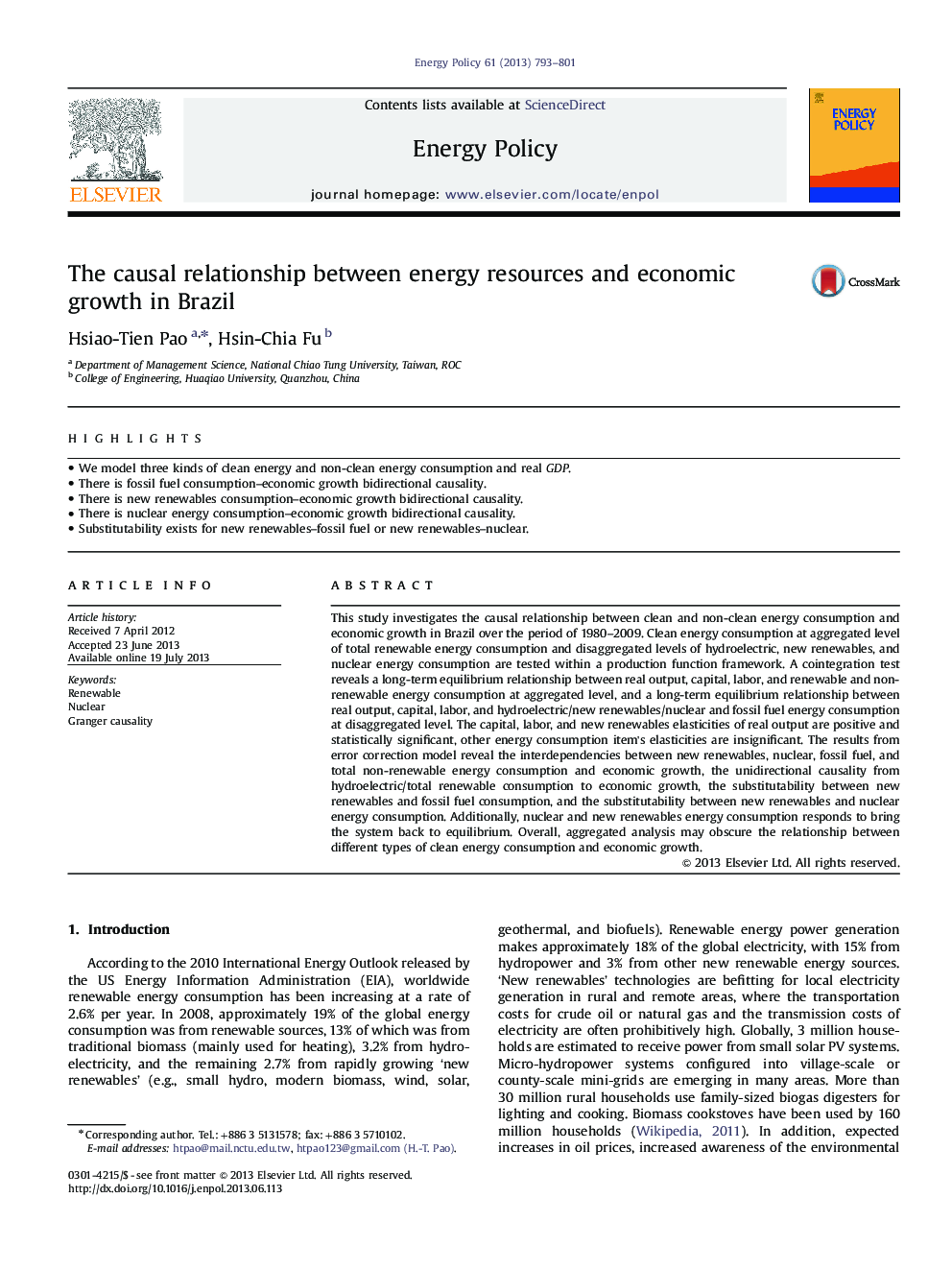| کد مقاله | کد نشریه | سال انتشار | مقاله انگلیسی | نسخه تمام متن |
|---|---|---|---|---|
| 7404937 | 1481297 | 2013 | 9 صفحه PDF | دانلود رایگان |
عنوان انگلیسی مقاله ISI
The causal relationship between energy resources and economic growth in Brazil
ترجمه فارسی عنوان
رابطه علی بین منابع انرژی و رشد اقتصادی در برزیل
دانلود مقاله + سفارش ترجمه
دانلود مقاله ISI انگلیسی
رایگان برای ایرانیان
کلمات کلیدی
تجدید پذیر، اتمی، علیت گرنجر،
ترجمه چکیده
در این تحقیق ارتباط بین مصرف انرژی تمیز و غیر تمیز و رشد اقتصادی برزیل طی دوره 1980 تا 2009 بررسی شده است. مصرف انرژی پاک در سطح جمع آوری کل مصرف انرژی تجدید پذیر و سطوح مختلف انرژی های آبی، انرژی های تجدید پذیر و انرژی هسته ای در یک چارچوب عملکرد تولید آزمایش می شود. یک تست هم اندیشی نشان می دهد که رابطه بلندمدت بین تولید واقعی، سرمایه، نیروی کار و مصرف انرژی تجدید پذیر و غیر قابل تجدید در سطح جمع آوری شده، و رابطه ی بلندمدت تعادلی واقعی بین تولید واقعی، سرمایه، نیروی کار و انرژی های نوآورانه برق آبی / / مصرف انرژی هسته ای و سوخت فسیلی در سطح تقسیم شده. پتانسیل سرمایه، نیروی کار و انرژی های تجدید پذیر جدید از تولید واقعی، از لحاظ مثبت و آماری معنی دار است، انعطاف پذیری موارد دیگر مصرف انرژی، ناچیز است. نتایج حاصل از مدل تصحیح خطا نشان می دهد که وابستگی های بین انرژی های تجدید پذیر جدید، هسته ای، سوخت های فسیلی و مصرف انرژی های غیر قابل تجدید و رشد اقتصادی، علیت ناحیه ای از مصرف انرژی تجدید پذیر هیدروالکتریک / کل به رشد اقتصادی، جایگزینی بین انرژی های تجدید پذیر جدید و سوخت فسیلی مصرف و جایگزینی بین انرژی تجدیدپذیر جدید و مصرف انرژی هسته ای. علاوه بر این، مصرف انرژی انرژی هسته ای و انرژی جدید پاسخ می دهد تا سیستم را به سمت تعادل برساند. به طور کلی، تحلیل تلفیقی ممکن است رابطه بین انواع مختلف مصرف انرژی پاک و رشد اقتصادی را نادیده بگیرد.
موضوعات مرتبط
مهندسی و علوم پایه
مهندسی انرژی
مهندسی انرژی و فناوری های برق
چکیده انگلیسی
This study investigates the causal relationship between clean and non-clean energy consumption and economic growth in Brazil over the period of 1980-2009. Clean energy consumption at aggregated level of total renewable energy consumption and disaggregated levels of hydroelectric, new renewables, and nuclear energy consumption are tested within a production function framework. A cointegration test reveals a long-term equilibrium relationship between real output, capital, labor, and renewable and non-renewable energy consumption at aggregated level, and a long-term equilibrium relationship between real output, capital, labor, and hydroelectric/new renewables/nuclear and fossil fuel energy consumption at disaggregated level. The capital, labor, and new renewables elasticities of real output are positive and statistically significant, other energy consumption item's elasticities are insignificant. The results from error correction model reveal the interdependencies between new renewables, nuclear, fossil fuel, and total non-renewable energy consumption and economic growth, the unidirectional causality from hydroelectric/total renewable consumption to economic growth, the substitutability between new renewables and fossil fuel consumption, and the substitutability between new renewables and nuclear energy consumption. Additionally, nuclear and new renewables energy consumption responds to bring the system back to equilibrium. Overall, aggregated analysis may obscure the relationship between different types of clean energy consumption and economic growth.
ناشر
Database: Elsevier - ScienceDirect (ساینس دایرکت)
Journal: Energy Policy - Volume 61, October 2013, Pages 793-801
Journal: Energy Policy - Volume 61, October 2013, Pages 793-801
نویسندگان
Hsiao-Tien Pao, Hsin-Chia Fu,
